Gigabyte GA-P55M-UD2 - P55 uATX Goodness for Under $105 - Updated
by Gary Key on August 28, 2009 12:00 PM EST- Posted in
- Gary's First Looks
We will finish up our P55 previews this weekend (or later) with a couple of new boards from ASUS and Biostar. In the meantime, I just wanted to comment on the Gigabyte GA-P55M-UD2. I have over a dozen P55 boards in the labs with several more arriving shortly. Already, two motherboards have risen to the top in regards to overclocking performance and a couple of boards have really impressed me with their balance of great performance and excellent feature sets.
That said, this particular board has been the most fun so far in testing. However, I will confess that I am partial to solid performing, budget priced, uATX form factor boards so my comments on these products tend to have some rah-rah in them if they perform well. Speaking of performance, I cannot comment on the numbers due to the NDA. Even though we have half a dozen retail purchased processors, memory kits, coolers, and this motherboard, Intel is sticking to their guns about violating the NDA release on i5/P55.
So that leaves me with providing vague comments like the board having a very good performance to price ratio. Maybe something along the lines of "I just cannot believe it does not cost more" is appropriate considering the feature set and performance compared to a few other boards.
This does not mean the board is going to hit 272 Bclks or provide class leading performance. It just means that spending less than $105 for this board and pairing it up with a Core i5-750 is going to lead to some fun times for the P55 budget seekers, HTPC groupies, or the SFF gaming crowd. We have word from ASRock and Foxconn that they will be providing $100 uATX P55 boards but we have not seen the feature sets yet.
Let's take a quick look at the GA-P55M-UD2. I forgot to mention, you can purchase this board now (as we did) from Provantage for less than $105. Update - The board is sold out again but should be in back in stock shortly, probably at less than $100.

Considering the limited board space, Gigabyte did a very good job fitting all of the peripherals onto this board. About the only negatives we can think of is the continued inclusion of the floppy drive port and the lack of passive cooling for the MOSFET area. The board only sports two fan headers so that might also be a problem for users with two or more 3-pin case fans. The board does support CrossFireX operation although we highly recommend against this setup as the second PCIe x16 slot is actually an x4 electrical slot running off the P55 chipset. The board contains Gigabyte's UltraDurable 3 technology that features their 2oz. copper based PCB, solid capacitors, low RDS(on) MOSFETs, and ferrite core chokes.
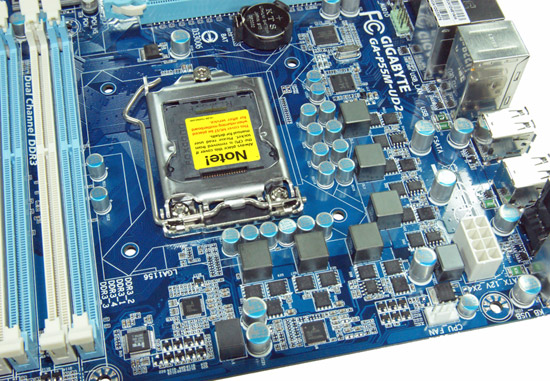
Gigabyte utilizes a solid six-phase PWM setup on this board. The CPU area is open for the most part and will accommodate larger coolers like the Thermalright MUX 120. Large push/pull coolers like the Vigor Monsoon III LT will block the first DIMM slot. If you plan on running this board with Bclk rates above 170 or so, we suggest additional airflow across the MOSFETs to ensure 24/7 stability when overclocking.
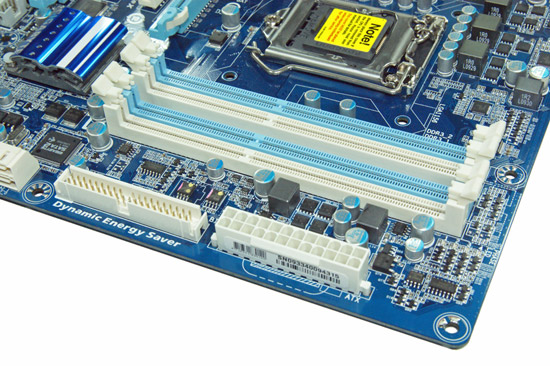
The IDE port, 24-pin ATX power connector, and the four DIMM slots are located in the lower right hand corner of the board. This board supports dual channel memory configurations and 16GB of DDR3 memory when using 4GB DIMMS. Installing the memory with a video card inserted in the first slot is difficult but not impossible.
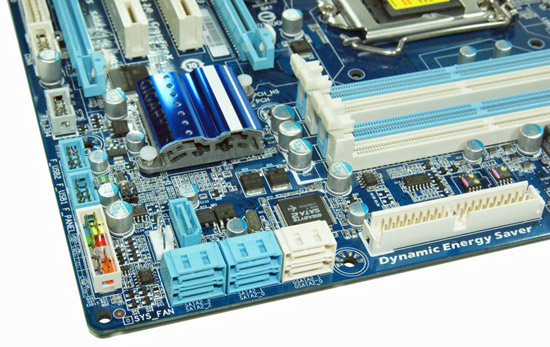
There are five (blue) SATA 3Gb/s ports provided by the P55 chipset that support RAID 0, 1, 5, 10. The sixth port available on the P55 (under the blue heatsink) is utilized on the I/O panel for eSATA. Gigabyte includes the JMicron JMB363 3Gb/s SATA chip that drives the two white SATA ports and provides IDE support. The front panel header, two USB headers, and the IEEE 1394a header are located at the edge of the board.
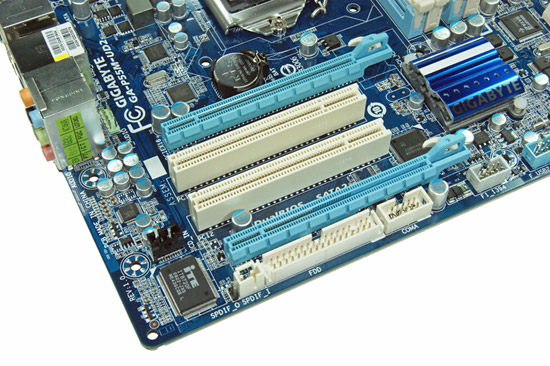
Gigabyte includes two PCIe x16 slots (x16 operation for the first slot, x4 operation for the second slot) and two PCI slots. The first PCI slot will be unavailable when utilizing a dual slot video card.
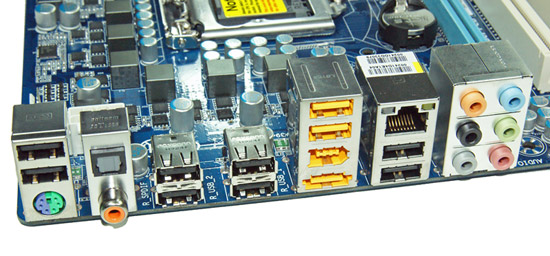
Last but not least is the I/O panel. We have ten USB 2.0 ports (total of fourteen on the board), combination PS/2 port, single eSATA port, IEEE 1394a port offered by the TI TSB43AB23 chipset, Gigabit Ethernet LAN port via the Realtek RTL8111D chipset, optical out/coaxial out S/PDIF ports, and the audio panel that provides 8-channel audio output via the Realtek ALC 888B HD audio codec.
BIOS Information
Apparently this preview did not have enough substance in it according to a few reader comments. I totally agree. However, I will state this one more time, we are bound by an NDA and cannot provide that substance for another week or so. That said, we can now show the general layout of the BIOS, thus providing a little more substance than we had yesterday. I will leave it at that for now.

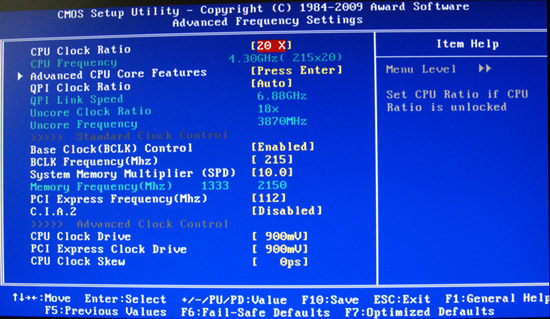
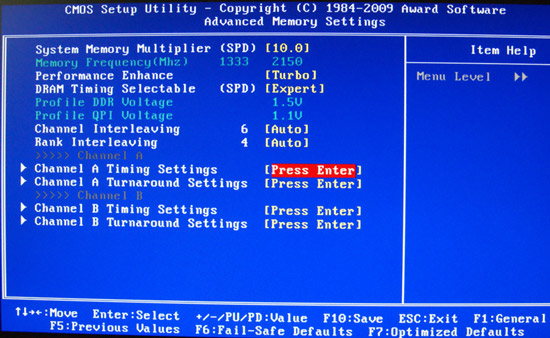


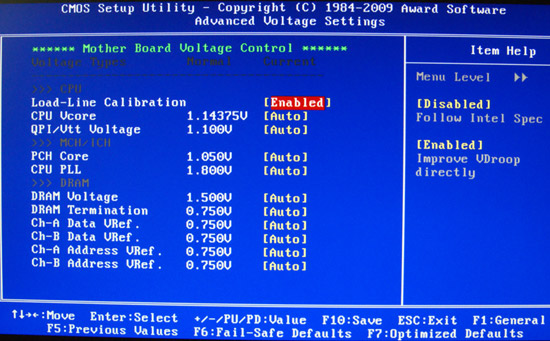






















76 Comments
View All Comments
T2k - Tuesday, September 1, 2009 - link
http://vr-zone.com/forums/477536/asus-p7p55d-premi...detailed.html
mczak - Monday, August 31, 2009 - link
This is a nice little board from the looks of it, however I'm not too sure it's really ideal for HTPC.I think cpu is way overpowered for this use (and hence requires too much cooling and costs too much), plus you'll need a dedicated graphic card which is going to use more power than a IGP. Now if you want to do some gaming on your HTPC this fits the bill, but for a strict HTPC something with a dual-core cpu plus some IGP (which can do h.264 decoding) is really all you want/need.
So Lynnfield/P55 doesn't look like the right solution to me. Clarkdale/H55 looks to be much better suited for that.
Gary Key - Monday, August 31, 2009 - link
I agree from a pure HTPC viewpoint that the H55/H57 would be a better alternative or even just sticking with a current Core 2 and GF9300/G45 or AMD Athlon II with a GF8300. That assumes multi-channel LPCM output is of prime importance, if not the Athlon II and a 785G board is a terrific value for an entry level media machine. I actually have grown fond of the ION platform, but the inability of it to properly accelerate Hulu is a killer for me.However, the unit in my living room has to do double duty as not only a media hub but also as a gaming system. So this board, an i5-750, and HD 4890 makes sense. Whether or not it will replace the current 790GX/720BE/HD 4890 setup is up in the air until next week. ;)
piasabird - Monday, August 31, 2009 - link
Every time I see a Legacy Floppy and IDE drive all I think of is why bother? Why dont motherboards just use a standard flash drive to update the bios? Seems like the extra space used by the IDE and Floppy interface could be put to better use.What happened to triple channel DDR3? 3 memory dimms with 2 gigs each and equaling 6 gigs, may be better than upgrading to 8 gigs. Does triple channel DDR3 RAM just not work? Seems like a lot of systems are being built and sold using the 64 bit version of windows and 4 gigs may not really be enough for a 64 bit OS. I plan on using a 64 bit version on next build and am wordering about this. I have seen some posts saying motherboards with DDR3 triple channel are not stable enough.
I dont overclock. I was thinking of using an Intel Brand Corporate stable motherboard or possible adding a versatile video card with HDMI/DVI-I so I can use HDMI or VGA, etc. I think the model is something like DG45CB or something like that. Comes with 4 memory slots. This type of motherboard might be a good comparison for benchmarks to see what kind of improvement you would expect to get. Benchmarks with separate video cards might be nice also.
strikeback03 - Monday, August 31, 2009 - link
Triple-channel memory is limited to the LGA1366 processorsIan0921 - Monday, August 31, 2009 - link
do you have info on when/if we are going to see any itx p55/i5 or i5/some other chipset boards?Gary Key - Monday, August 31, 2009 - link
I do not think we will see a mini-ITX based P55 system after speaking with the suppliers. I know a couple were working on them but it does not appear they will bring those to market. Expect to see H55/H57 (IG version) mini-ITX boards when those chipsets launch later this year or early next year. We just might see a P57 mini-ITX board next spring. ;)haplo602 - Monday, August 31, 2009 - link
I have one interesting observation. There are loads of P55 articles around the net while the boards and CPUs are not even selling, however there were exactly 0 785G board reviews since the launch of the chipset. OK P55 and i5 are more interesting, but the lack of 785G reviews is a bit strange.I guess the fine Intel got from the EC is valid after all.
Gary Key - Monday, August 31, 2009 - link
We will have the 785G roundup in September as part of the AMD chipset review. Actually, that testing has been ongoing since AMD released the 9.8 drivers, which were two builds newer than what we utilized in the chipset launch article and perform differently. Not to mention the fiasco with multi-channel LPCM output (which is worse than I imagined) and we had a perfect storm here based on the P55 launch and a few other new items launching this month.Also, the 785G launch was rushed by AMD and the motherboard suppliers have finally addressed several of our BIOS concerns. This along with boards from ECS, Biostar, MSI, and Foxconn will help us round out what would have been a Gigabyte/ASUS only review.
haplo602 - Monday, August 31, 2009 - link
ah, but there are boards with 785G selling already. the LPCM issue is not of much concern for most people. and any bugs/driver issues NOT reported just make matters worse for the end user.